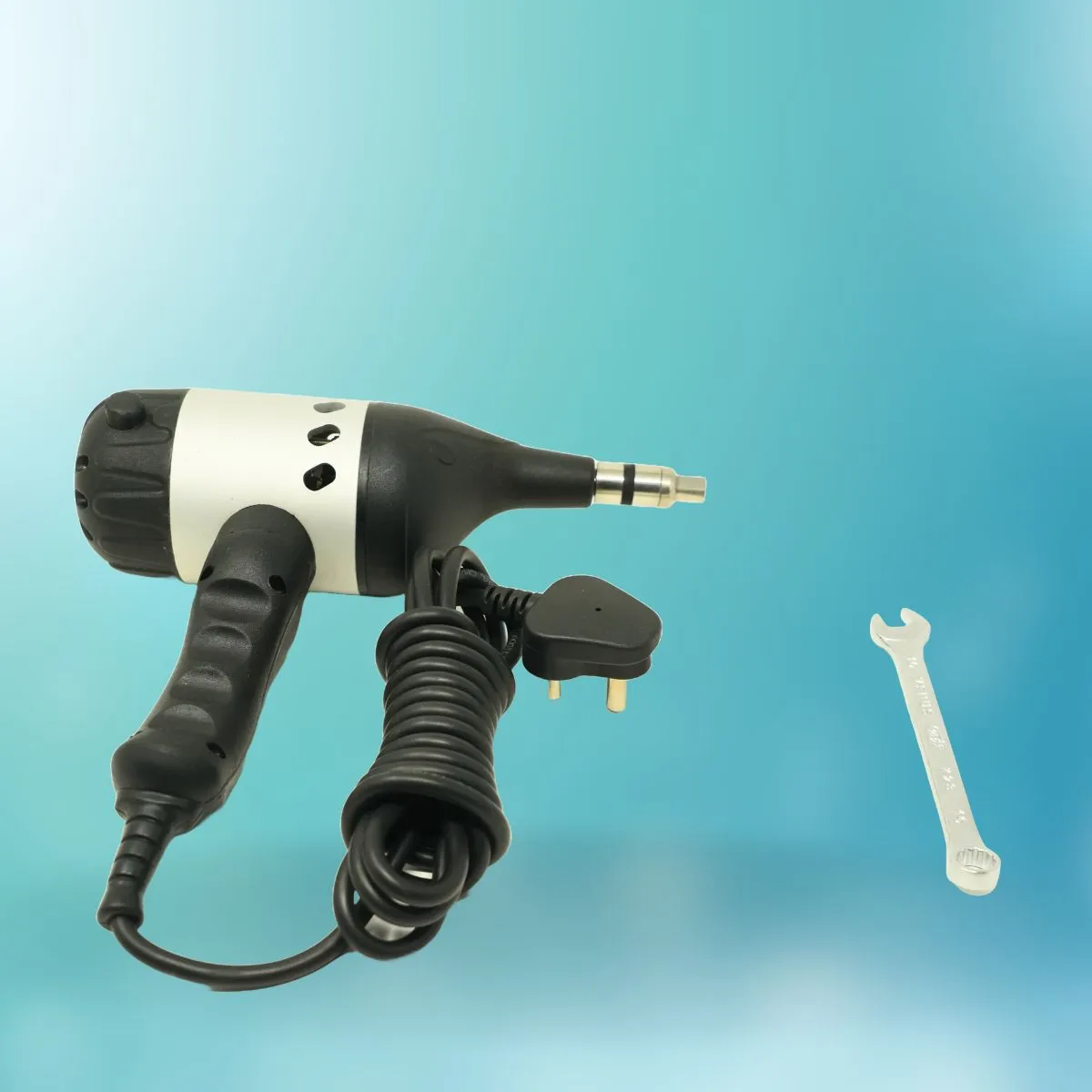PLASTER CUTTER
Description
A plaster cutter is a specialized medical tool used in orthopedics to safely and efficiently remove plaster casts from a patient’s body after a fracture has healed or when a cast needs to be replaced. It is designed to cut through the hard outer layer of a plaster cast while protecting the patient's skin and underlying tissues from injury. This tool is essential in ensuring that the removal process is done quickly and safely, minimizing discomfort or harm to the patient.
Design and Function:
The plaster cutter consists of a small, motorized blade that oscillates back and forth rather than rotating, which allows it to cut through the plaster material without causing damage to the skin. The cutting blade is housed in a protective casing, typically made of durable plastic, to ensure that the sharp edges of the tool do not accidentally come into contact with the patient’s skin.
The cutter works by producing high-frequency vibrations, which allow it to slice through the cast material. Since plaster is a rigid and dense material, the oscillating motion of the blade is much more effective than traditional, straight-cutting blades. This action makes it easier to remove the cast while minimizing the risk of injury.
Applications in Orthopedic Care:
-
Cast Removal: The primary use of a plaster cutter is during the removal of plaster casts once a bone or joint injury has healed. After a fracture or surgical procedure, a cast is typically applied to immobilize the injured area. Once the healing is complete, the plaster cutter is used to safely and quickly cut through the cast, allowing it to be removed without harming the patient’s skin.
-
Post-Operative Care: In cases where orthopedic surgery is performed, a plaster cast may be used to stabilize the area post-surgery. The plaster cutter allows healthcare providers to remove the cast once the healing process is sufficient, enabling rehabilitation to begin.
-
Fracture Management: After a patient’s bone fracture has healed sufficiently, the plaster cutter is essential in removing the cast, facilitating the patient's transition from immobilization to physical therapy and movement. It is used in routine follow-ups to ensure that the cast is removed safely.
-
Removing Old or Damaged Casts: If a plaster cast becomes damaged, cracked, or improperly fitted, the plaster cutter is used to remove it to ensure proper healing and comfort for the patient. A cutter may also be used in cases where a new cast needs to be applied, and the old one must be removed first.
Benefits:
-
Safety: The design of the plaster cutter ensures the safety of the patient by preventing accidental skin injury. The oscillating blade and protective casing prevent direct contact with the skin, reducing the risk of cuts or abrasions.
-
Efficiency: The plaster cutter is much faster and more effective than traditional methods like using scissors or saws, allowing healthcare providers to remove the cast quickly and with minimal discomfort to the patient.
-
Comfort: Compared to older techniques for cast removal, such as using a saw or scalpel, the plaster cutter provides a less invasive and more comfortable experience for the patient. The patient doesn’t feel the vibrations, and the procedure is relatively painless.
-
Reduced Risk of Complications: Because the tool does not apply excessive pressure or heat, there is less risk of skin irritation, burns, or soft tissue damage, which might occur with older tools. The oscillating nature of the blade prevents excessive pressure from being applied to the skin.
Features of a Plaster Cutter:
- Oscillating Blade: The cutter features a blade that moves back and forth rapidly rather than rotating. This movement prevents the blade from cutting into the patient’s skin while effectively slicing through the plaster.
- Protective Guard: The cutter has a protective guard that shields the blade from coming into direct contact with the patient’s skin. This guard is a crucial safety feature, ensuring that only the cast material is cut.
- Motorized Mechanism: Most plaster cutters are powered by a small electric motor that drives the blade's oscillating movement. Some models may be battery-operated for ease of use in various settings.
- Adjustable Speed: Some modern plaster cutters offer adjustable speed settings, allowing healthcare providers to control the cutting speed based on the cast material's thickness and hardness.
Considerations:
-
Noise: The motorized operation of the plaster cutter can be somewhat noisy, which might cause anxiety for some patients, particularly children. However, the benefits of quick and safe removal usually outweigh this inconvenience.
-
Training and Familiarity: Healthcare providers need to be properly trained in using the plaster cutter to ensure that it is used safely and effectively. Improper handling can result in accidents or discomfort for the patient.
-
Patient Comfort: While the procedure is typically painless, some patients, especially those who have sensitive skin or a fear of the noise and vibration, may experience mild anxiety or discomfort during the cast removal. Proper patient preparation and reassurance can help ease this.
-
Maintenance: Like any medical tool, the plaster cutter needs to be regularly maintained to ensure it works efficiently. The blade and motor should be checked for wear and tear, and the protective guard should be kept clean and intact to ensure safety.
Conclusion:
The plaster cutter is an essential tool in orthopedic care, offering a quick, efficient, and safe method for removing plaster casts. By using oscillating blades and a protective casing, it minimizes the risk of injury while ensuring that the cast can be removed without difficulty. This tool significantly enhances patient safety and comfort, making the post-fracture or post-surgical experience much smoother. Whether for routine cast removal or in cases where the cast has become damaged, the plaster cutter is a vital instrument in modern orthopedic practices, improving both the experience for patients and the efficiency of healthcare providers.


